Articles
- Page Path
- HOME > J Musculoskelet Trauma > Volume 33(2); 2020 > Article
- Case Report Femoral Head Fracture with Hip Dislocation Treated by Autologous Osteochondral Transfer (Mosaicplasty) - A Case Report -
- Eui-Sung Choi, Hyun-Chul Shon, Ho-Seung Jeong, Jae-Young Yang, Seok-Hyun Hong, Byung-Hyun Ahn
-
Journal of Musculoskeletal Trauma 2020;33(2):96-100.
DOI: https://doi.org/10.12671/jkfs.2020.33.2.96
Published online: April 30, 2020

- 502 Views
- 1 Download
- 1 Crossref
- 0 Scopus
Abstract
Femoral head fractures combined with hip dislocation are very rare injuries. In most cases, they result from high-energy trauma to the hip or lower extremity during traffic accidents. Various therapy options have been suggested to treat these injuries. Especially, different joint-preserving surgical options have been described for the treatment of traumatic osteochondral injury of the femoral head in young, active patients. In this report, we present a case that a traumatic osteochondral lesion to the femoral head after hip dislocation was treated with osteochondral autografts (OATS) from the non-weight-bearing area of the ipsilateral inferior femoral head through a surgical hip dislocation. After 1 year, the clinical and radiological outcome was satisfactory with no evidence of posttraumatic osteoarthritis and no pain of patients.
Published online Apr 28, 2020.
https://doi.org/10.12671/jkfs.2020.33.2.96
Femoral Head Fracture with Hip Dislocation Treated by Autologous Osteochondral Transfer (Mosaicplasty): A Case Report
 , M.D., Ph.D.,
Hyun-Chul Shon
, M.D., Ph.D.,
Hyun-Chul Shon , M.D., Ph.D.,
Ho-Seung Jeong
, M.D., Ph.D.,
Ho-Seung Jeong , M.D.,
Jae-Young Yang
, M.D.,
Jae-Young Yang , M.D.,
Seok-Hyun Hong
, M.D.,
Seok-Hyun Hong , M.D.
and Byung-Hyun Ahn
, M.D.
and Byung-Hyun Ahn , M.D.
, M.D.
Abstract
Femoral head fractures combined with hip dislocation are very rare injuries. In most cases, they result from high-energy trauma to the hip or lower extremity during traffic accidents. Various therapy options have been suggested to treat these injuries. Especially, different joint-preserving surgical options have been described for the treatment of traumatic osteochondral injury of the femoral head in young, active patients. In this report, we present a case that a traumatic osteochondral lesion to the femoral head after hip dislocation was treated with osteochondral autografts (OATS) from the non-weight-bearing area of the ipsilateral inferior femoral head through a surgical hip dislocation. After 1 year, the clinical and radiological outcome was satisfactory with no evidence of posttraumatic osteoarthritis and no pain of patients.
Fig. 1
(A) Anteroposterior Hip radiograph shows left femoral head fracture. (B) Axial computed tomography image shows a left hip posterior dislocation with Pipkin type II femoral head fracture.
Fig. 2
(A) Postreduction axial computed tomography (CT) image shows a correct position of the femoral head. (B) Postreduction coronal CT scan shows a defect of the anterior-superior weight bearing dome of the femoral head.
Fig. 3
(A) An intraoperative image of the femoral head after a surgical hip dislocation. (B) An intraoperative image showing placement of Acutrak (Acuemd) for fixation of the main fragment after anatomical reduction. A large osteochondral defect in the weight-bearing surface of the femoral head is visible.
Fig. 4
(A) An intraoperative image showing harvesting 10-mm-diameter two osteochondral plugs from the inferior non-weight-bearing surface. (B) Final image showing a smooth contour after insertion of the donor plugs and greater trochanter autograft.
Fig. 5
(A) One year follow-up plain radiograph shows no evidence of the collapse of femoral head. (B) Coronal computed tomography image at 1 year postoperatively, showing no evidence of posttraumatic osteoarthritis or the collapse of femoral head.
Financial support:None.
Conflict of interests:None.

 E-submission
E-submission KOTA
KOTA TOTA
TOTA TOTS
TOTS
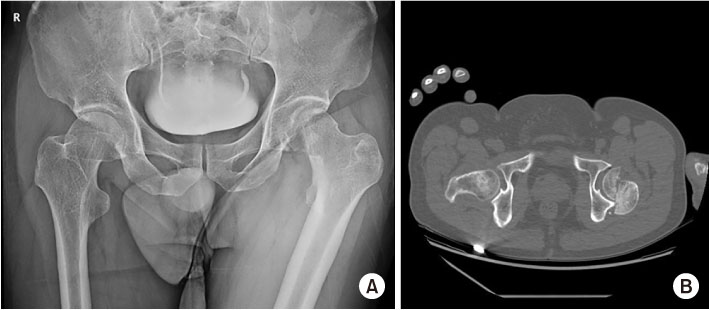
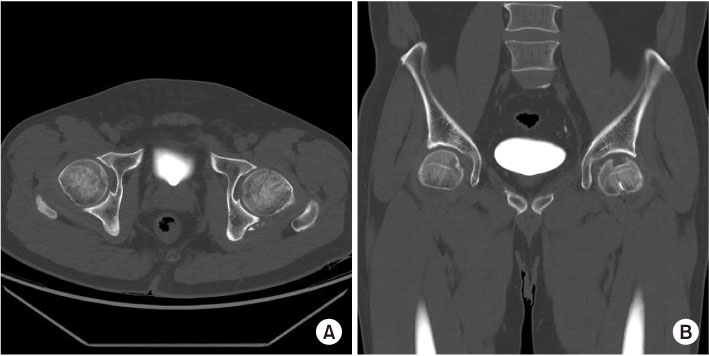
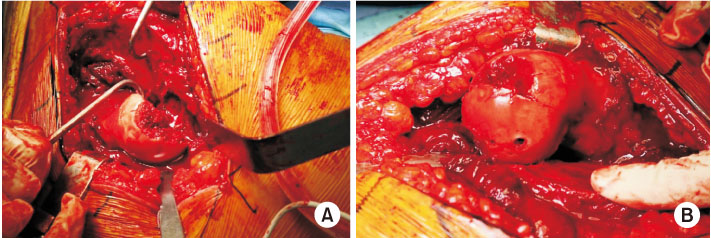
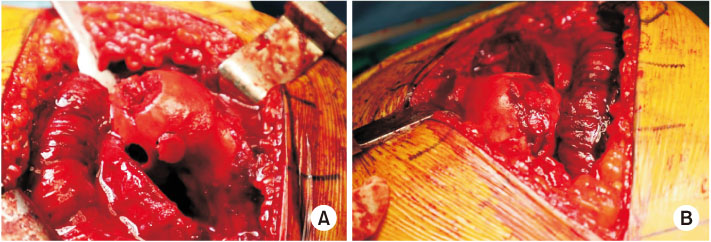
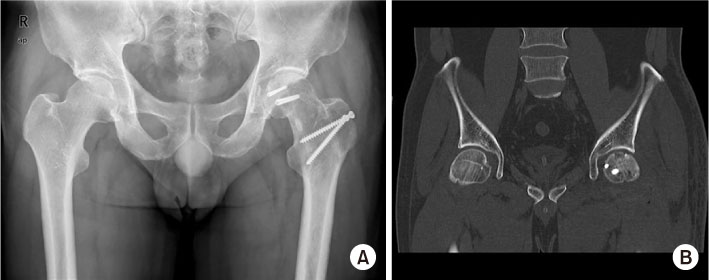

 Cite
Cite

